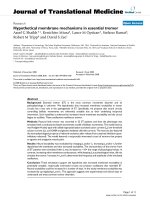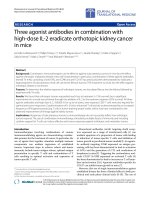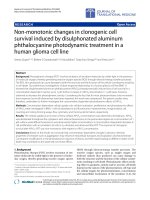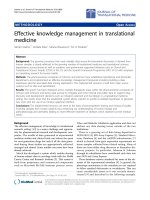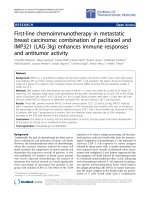báo cáo hóa học: " F-fluoride PET: changes in uptake as a method to assess response in bone metastases from castrate-resistant prostate cancer patients treated with 223Ra-chloride (Alpharadin)" pdf
Bạn đang xem bản rút gọn của tài liệu. Xem và tải ngay bản đầy đủ của tài liệu tại đây (377.5 KB, 6 trang )
PRELIMINARY RESEARCH Open Access
18
F-fluoride PET: changes in uptake as a method
to assess response in bone metastases from
castrate-resistant prostate cancer patients treated
with
223
Ra-chloride (Alpharadin)
Gary JR Cook
1*
, Chris Parker
2
, Sue Chua
1
, Bernadette Johnson
2
, Anne-Kirsti Aksnes
3
and Val J Lewington
1
Abstract
Background: A qualitative assessment of conventional bone scintigraphy with
99m
Tc methylene diphosphonate is
perceived as an insensitive method for monitoring the treatment response of bone metastases, and we postulated
that semi-quantitative
18
F-fluoride positron emission tomography (PET) might serve as a suitable alternative
biomarker of the treatment response.
Methods: Five patients with castrate-resistant prostate cancer and bone metastases with no known soft tissue
disease received 100 kBq/kg of radium-223 (
223
Ra)-chloride (Alpharadin) therapy at 0 and 6 weeks and had whole
body
18
F-fluoride PET scans at baseline, 6 and 12 weeks with concurrent prostatic-specific antigen (PSA) and
alkaline phosphatase (ALP) measurements. A qualitative compa rison of the PET scans was performed blinded to
the PSA and ALP results. A semi-quantitative comparison was made by measuring the maximum standardised
uptake values (SUVmax) in five bone metastases in each patient. The means of the five SUVmax measurements in
each subject were used as a quantitative me asure of global metastatic activity at each time point.
Results: Three patients showed a PSA decline at 12 weeks (-44%, -31%, -27% reduction) whilst two patients
showed PSA increases (+10%, +17%). All five patients showed a reduction in ALP of greater than 25%. The
qualitative assessment of the
18
F-fluoride scans recorded a stable disease in each case. However, the semi-
quantitative assessment showed agreement with the PSA decline in three patients (-52%, -75%, -49%) and minimal
change (+12%, -16%) in two patients with increased PSA at 12 weeks. Four patients showed similar reductions in
mean SUVmax and ALP at 12 weeks.
Conclusions: The semi-quantitative
18
F-fluoride PET is more accurate than the qualitative comparison of scans in
assessing response in bone metastases, correlating with the PSA response and ALP activity and offering a potential
imaging biomarker for monitoring treatment response in bone metastases following treatment with
223
Ra-chloride.
Background
Prostate cancer is the commonest cancer in men in the
UK and is the second most common male cancer world-
wide [1]. Bone metas tases are common in patients with
prostate cancer, and approximately 70% of patients have
evidence of skeletal disease at post-mortem [2]. Bone
metastases are associated with significant morbidity
includi ng pain, pathological fracture and cord compres -
sion, and the median survival is 20 months [2]. The
demands on health care resources can be great, and it is
therefore important that accurate methods are available
to monitor therapy which can giv e an indication of suc-
cess or failure early in the course of treatment as part of
routine clinical management or within the context of
clinical trials.
However, bone metastases are notoriously difficult to
monitor during tre atment, and in practice a combina-
tion of clinical, biochemical (e.g. prostate-specific
* Correspondence:
1
Department of Nuclear Medicine and PET, Royal Marsden Hospital, Sutton,
UK
Full list of author information is available at the end of the article
Cook et al. EJNMMI Research 2011, 1:4
/>© 2011 Cook et al; licensee Springer. This is an Open Access article distributed under the terms of the Creative Commons Attribution
License
antigen (PSA), serum alkaline phopshatase (ALP)) and
imaging assessments are used [3]. However, it is gener-
ally accepted that the current methods are insensitive
and often non-specific compared to those used for soft
tissue disease. The measurement of response in bone
metastases remains a chal lenge in routine oncological
practice and in clinical trials,totheextentthatbone
metastases are often regarded as a non-measurable dis-
ease [4]. Criteria exist which use radiographic changes
to measure response in bone metastases, but t hese are
relatively insensitive, taking a number of months for
changes to occur [5]. In addition, the criterion of sclero-
sis of previously osteolytic metastases is not relevant for
metastatic disease that is predominantly sclerotic at
baseline, as can occur in a number of cancers and is
particularly common in prostate cancer. As an alterna-
tive to morphological imaging methods there has pre-
viously been some interest in using functional bone-
specific imaging methods such as
99m
Tc-methylene
diphosphonate (MDP) scintigraphy. However, it has
been shown that the bone scan is limited in its sensitiv-
ity to measure treatment effect, with only 52% of
responders showing scintigraphic improvement and 62%
of non-responders showing scintigraphic deterioration at
6 to 8 months in one early study of patients with breast
cancer [6]. In an attempt to increase sensitivity o f
response measurement, some authors have described
various semi-quantitative means of following bone
metastases with bone scintigraphy [7-10], but others
have found no advantage over visual interpretation [11]
and quantitative m ethods have not gained acceptance
into routine practice.
18
F-fluoride was first described as a bone imaging
agent nearly 40 years ago [12], but it is only in recent
years, with improvements in positron emission tomogra-
phy (PET) imaging equipment and resultant high-quality
images, that t here has been renewed interest in this tra-
cer. Bone-specific imaging with
18
F-fluoride PET and
PET/CT has shown increased diagnostic accuracy com-
pared to
99m
Tc-MDP planar and/or single-photon emis-
sion computed tomography (SPECT) imaging in
prostate and other cancers [13-18]. PET also offers the
inherent advantage of superior quantitative accuracy
over planar or SPECT scintigraphy, and we postulated
that semi-quantitative
18
F-fluoride PET might allow an
accurate and timely measurement of the treatment
response in bone metastases from prostate cancer. A
previous report describ es changes in
18
F-fluoride uptake
measur ed with PET following bisphosp honate treatment
of glucocorticoid-induced osteoporosis [19], but t o our
knowledge, this method has not been used to monitor
the treatment effects in bone metastases. The purpose
of this pilot study was to demonstrate the early treat-
ment response to radium-223 (
223
Ra)-chloride
(Alpharadin, Algeta ASA, Oslo, Norway), a bone-seeking
alpha emitter with a half-life of 11.4 days, using semi-
quantitative
18
F-fluoride PET and to compare wit h
changes in biochemical markers including PSA as a
tumour marker and ALP as a bone formation marker.
Methods
This imaging study was performed as a pilot substudy of
an open-label phase 1 trial of Alpharadin in patients with
bone metastases and castration-resistant prostate cancer.
Repeated
18
F-fluoride PET imaging, PSA and ALP assess-
ments were performed to assess treatment response. Bio-
chemical results were retrieved from an institutional
electronic patient record corresponding to the timing of
the PET scans. Approval for this study was obtained from
a research ethics committee and the national Administra-
tion of Radioactive Substances Advisory Committee, and
the patients provided written informed consent.
Five male subjects with osteoblastic bone metastases
from castration-resistant prostate cancer, as determined
by
99m
Tc-MDP bone scintigraphy and with no evidence
of nodal or visceral disease on CT scan, were included
in this pilot study. The mean age was 63.2 years (range,
57 to 70 years).
The subjects received 100 kBq/kg of
223
Ra-chloride
intravenously at baseline and after 6 weeks. PSA, ALP
and
18
F-fluoride PET measurements were performed at
baseline before the first administration, at 6 weeks just
before the second administration and at 12 weeks to
assess treatment response.
Awholebody
18
F-fluoride PET imaging was per-
formed 1 h following injection of 250 MBq
18
F-fluoride
on a Gemini PET/CT scanner (Philips Medical Systems,
Cleveland, OH, US).
Data were acquired for 3.5 min per bed position follow-
ing a low-current (50 mAs) CT scan performed for
attenuation correction and lesion localisation. Scans were
asse ssed quali tatively by visual inspection for evidence of
response at 6- and 12-week time points compared to the
baseline s can and wit hout knowledge of the PSA or ALP
results. The images were analysed using the Hermes
Gold 3 softwar e (Hermes Medical Solutions, Stockholm,
Sweden). For the semi-quantitative assessment, five
representative bone metas tases were chosen that were
greater than 2 cm in diameter in each subject. Lesions
were selected to represent both axial and appendicular
sites when present and the maximum st andardised
uptake value (SUVmax) calculated from an ROI of each
lesion. The average SUVmax of the five lesions was then
calculated for each patient at each scanning time point.
Results
The qualitative interpretati on resulted in a classification
of stable diseases in all five cases with no perceptible
Cook et al. EJNMMI Research 2011, 1:4
/>Page 2 of 6
differe nce in uptake or number of lesions (Figure 1). In
the semi-quantitative analysis, only one subject showed
a significant reduction in mean SUVmax at 6 weeks
(-32.5%, subject A in Figure 2), and t his subject and
two others showed a significant reduction at 12 weeks
(-52.4%, -75.3% and -48.8%, subjects A, B and C, respec-
tively in Figure 2) (Table 1). Two subjects showed mini-
mal changes at 6 and 12 weeks (-8%, -9% at 6 weeks
and +11.6%, -15.7% at 12 weeks, subjects D and E,
respectively in Figure 2). The three subjects who
showed reductions in mean SUVmax at 12 weeks also
showed reductions in PSA and ALP. The two subjects
that showed only minimal changes in mean SUVmax
both showed a small rise in PSA (+10.2, +17.3%, respec-
tively) but a greater than 25% drop in ALP at 12 weeks
(Figure 2).
Discussion
This pilot study has shown the feasibility of measuring
changes in the uptake of
18
F-fluoride with PET in
patients with bone metastases from prostate cancer
receiving systemic therapy with
223
Ra-chloride. Addi-
tionally, it has shown that the semi-quantitative analysis
using SUVs is able to measure changes not detected by
qualitative visual inspection.
In this study, three subjects (A, B a nd C) showed a
comparable reduction in
18
F-fluoride uptake in bone
metastases and in the biochemical parameters, PSA and
ALP at 12 weeks. A more consistent correlation was
present at 12 weeks than at 6 weeks. I n two other sub-
jects (D and E), small changes in
18
F-fluoride uptake of
less than 20% were seen, accompanied by small rises in
PSA of less than 20% in both subjects but with larger
changes in ALP (-43.8% and -26.2%, respectively) at 12
weeks.
18
F-fluoride is a bone-specific tracer and rather than
indicating tumour metabolic activity directly, it is a mar-
ker of the local osteoblastic reaction of bone that
accompanies most bone metastases [20]. In accordance
with this, a close correlation was seen between the mag-
nitude of reduction in
18
F-fluoride uptake and ALP at
12 weeks in four out of five of the subjects (Figure 2).
Figure 1 Qualitative response assessment. Maximum intensity projection images at 0 and 12 weeks in two subjects, subject A and subject B,
showing no significant qualitative change.
Cook et al. EJNMMI Research 2011, 1:4
/>Page 3 of 6
A potential weakness of an indirect assessment of
tumour activity by measuring parameters that primarily
reflect osteoblastic activity (i.e. ALP and
18
F-fluoride
uptake) is a temporal discordance in changes with
intrinsic tumour activit y. Although not observed in this
pilot study, the osteoblastic reaction to a metastasis by
bone may subside at a different rate than the metabolic
activity of the malignant tumour tissue, or an initial
increase in osteoblastic activity may occur as part of a
healing respons e in the surrounding bone of responding
metastases, the so-called flare phenomenon [21]. How-
ever, in this study, although not directly measuring
0.0
20.0
40.0
60.0
80.0
100.0
120.0
140.0
0.0 6.0 12.0
0.0
20.0
40.0
60.0
80.0
100.0
120.0
140.0
0.0 6.0 12.0
0.0
20.0
40.0
60.0
80.0
100.0
120.0
140.0
0.0 6.0 12.0
0.0
20.0
40.0
60.0
80.0
100.0
120.0
140.0
0 6.0 12.0
0.0
20.0
40.0
60.0
80.0
100.0
120.0
140.0
0.0 6.0 12.0
SUVmax
PSA
ALP
Figure 2 Mean SUVmax, PSA and ALP changes. Mean SUVmax, PSA and ALP changes at 6 and 12 weeks as a percentage of baseline levels in
the five subjects (A to E).
Table 1 Disease extent, measured metastatic sites and changes in mean SUVmax, PSA and ALP at 6 and 12 weeks
after first administration of
223
Ra
Subject
(disease
extent)
0 weeks 6 weeks 12 weeks
Measured sites Mean
SUVmax
(range)
Baseline
PSA (ng/ml)
Baseline
ALP (U/L)
SUV
(range)
[% of
baseline]
PSA
[% of
baseline]
ALP
[% of
baseline]
SUV
(range)
[% of
baseline]
PSA
[% of
baseline]
ALP
[% of
baseline]
A (6-20
metastases)
C6, T6, L Sacrum, R
ilium, L femur
46.4
(33.1-75.3)
370 118 31.3
(26.5-40.5)
[67.5%]
210
[56.8%]
47
[39.8%]
22.1
(16.7-28.2)
[47.6%]
207
[55.9%]
53
[44.9%]
B
(superscan)
C3, L1, L5, L femur,
R tibia
15.0
(13.2-17.2)
508 761 16.0
(11.9-21.1)
[106.7%]
459
[90.4%]
332
[43.6%]
3.7
(2.9-4.8)
[24.7%]
350
[68.9%]
225
[29.6%]
C (6-20
metastases)
L1, L3, L5, sternum,
R ischium
74.6
(54.7-98)
78 129 66.7
(51.3-76.7)
[89.4%]
92
[117.9%]
85
[65.9%]
38.2
(26.5-46.9)
[51.2%]
57
[73.1%]
70
[54.3%]
D (>20
metastases)
Skull, L scapula,
T11, L3, L ilium
27.5
(20.3-35.4)
551 89 25.3
(20.6-29.5)
[92%]
674
[122.3%]
53
[59.6%]
30.7
(21.1-59.4)
[111.6%]
607
[110.2%]
50
[56.2%]
E
(superscan
)
Skull, T12, L3, R
ilium, R femur
22.3
(11.4-28.6)
254 393 20.3
(11-25)
[91%]
273
[107.5%]
406
[103.3%]
18.8
(9.8-24.8)
[84.3%]
298
[117.3%]
290
[73.8%]
Cook et al. EJNMMI Research 2011, 1:4
/>Page 4 of 6
tumour cell activity, as might be possible with other
PET tracers including
18
F-fluorodeoxyglucose or radiola-
belled choline, changes in
18
F-fluoride uptake were simi-
lar to changes in PSA at 12 weeks.
Our study suggests that a 12-week semi-quantitative
assessment of
18
F-fluoride uptake is a closer predictor of
the biochemical PSA response than at 6 weeks. Previous
reports of the flare phenomenon measured biochemi-
cally with ALP [22] or with quantitative bone scintigra-
phy [8] show that it peaks and substantially subsides
before 2 months. These data may explain in part why
the 12-week
18
F-fluoride PET scan is a more reliable
measure of tumour response than the 6-week time
point. An assessment at 12 weeks after commencing sys-
temic therapy for bone metastases remains at an early
enough time point to be clinically relevant in informing
clinical management decisions and for measuring early
response in clinical trials.
A qualitative visual assessment of response using
18
F-
fluoride PET was i nsensitive to changes at 6 or 12
weeks in this study, and it is possible that for the same
reason, a qualitative interpretation of the
99m
Tc-MDP
bone scintigraphy has not found universal favour and is
relatively insensitive as a response assessment method,
unless there are unequivocal new lesions beyond the
expected flare period. In the absence of better imaging
biomarkers, PET also has the inherent advantage over
the conventional
99m
Tc-MDP bone scintigraphy of more
accurate and absolute quantification of radioactive tracer
concentrations, and therefore lends itse lf to a quantita-
tive approach. A potential weakness of the methodology
employed in this study was that the semi-quantitative
assessment was only performed in five lesions in each
subject. However, the lesions were chosen to represent
different areas of the skeleton and whi lst a global mea-
sure of skeletal metastases would be of utility, this has
practical limitati ons, particularly in patients with exte n-
sive disease. A full kine tic analysis of the dynamic PET
and blood data would also be of interest, but this
approach, whilst potentially more sensitive to sm all
changes in bone clearance of tracer, is also limited in
practicality.
These results are from a small pilot study, and the
conclusions on the ability of
18
F-fluoride PET to mea-
sure early response in bone metastases are limited. In
addition, it is not possible to extrapolate these results to
different forms of systemic therapy, including hormones
or chemotherapy, or in different tumour types where
the mechanism of action of individual drugs and the dif-
ferences in biological behaviour of tumour types and
effects on the skeleton may differ. Nevertheless, we
believe that the results are of sufficient interest to
encourage further research into using
18
F-fluoride PET
as a biomarker of response in bone metastases in a vari-
ety of cancers and treatment types.
Conclusions
The results of this pilot study suggest there may be a
role for semi-quantitative
18
F-fluoride PET as a method
to monitor t he treatment response in bone metastases
following systemic therapy with
223
Ra-chloride at clini-
cally relevant intervals.
Abbreviations
ALP: alkaline phosphatase; MDP: methylene diphosphonate; PET: positron
emission tomography; PSA: prostate-specific antigen; SUVmax: maximum
standardised uptake value.
Acknowledgements
The study was financially supported by Algeta ASA, Oslo, Norway and by
RMH/ICR NIHR Biomedical Research Centre Funding.
Author details
1
Department of Nuclear Medicine and PET, Royal Marsden Hospital, Sutton,
UK
2
Academic Urology Unit, Royal Marsden Hospital and Institute of Cancer
Research, Sutton, UK
3
Algeta ASA, Oslo, Norway
Authors’ contributions
GC study design, data acquisition, analysis, manuscript drafting and approval.
CP study design, coordination of study, manuscript drafting and approval. SC
data acquisition, manuscript drafting and approval. BJ coordination of study,
patient recruitment, manuscript drafting and approval. AKA study design,
coordination of study, manuscript drafting and approval. VL study design,
data acquisition, analysis, manuscript drafting and approval.
Competing interests
CP is a consultant to Algeta ASA.
Received: 17 January 2011 Accepted: 7 June 2011
Published: 7 June 2011
References
1. Prostate cancer - UK incidence statistics. [ />cancerstats/types/prostate/incidence/#geog].
2. Rubens RD: Bone metastases - incidence and complications. In Cancer
and the skeleton. Edited by: Rubens RD, Mundy GR. London: Martin Dunitz;
2000:33-42.
3. Clamp A, Danson S, Nguyen H, Cole D, Clemons M: Assessment of
therapeutic response in patients with metastatic bone disease. Lancet
Oncol 2004, 5:607-616.
4. Therasse P, Arbuck E, Eisenhauer E, Wanders J, Kaplan RS, Rubinstein L,
Verweij J, Van Glabbeke M, van Oosterom AT, Christian MC, Gwyther SG:
New guidelines to evaluate the response to treatment in solid tumours.
J Natl Cancer Inst 2000, 92:205-216.
5. Haywood JL, Carbone PP, Heuson JC, Kumaoka S, Segaloff A, Rubens RD:
Assessment of response to therapy in advanced breast cancer. Eur J
Cancer 1977, 13:89-94.
6. Coombes RC, Dady P, Parsons C, McCready VR, Ford HT, Gazet JC,
Powles TJ: Assessment of response of bone metastases to systemic
treatment in patients with breast cancer. Cancer 1983, 52:610-614.
7. Sundkvist GM, Ahlgren L, Lilja B, Mattsson S, Abrahamsson PA,
Wadström LB: Repeated quantitative bone scintigraphy in patients with
prostatic carcinoma treated with orchidectomy. Eur J Nucl Med 1988,
14:203-206.
8. Sundkvist GM, Björk T, Kjellström H, Lilja B: Quantitative bone scintigraphy
in patients with prostatic carcinoma treated with LH-RH analogues.
Scand J Urol Nephrol 1996, 30:29-32.
9. Imbriaco M, Larson SM, Yeung HW, Mawlawi OR, Erdi Y, Venkatraman ES,
Scher HI: A new parameter for measuring metastatic bone involvement
Cook et al. EJNMMI Research 2011, 1:4
/>Page 5 of 6
by prostate cancer: the Bone Scan Index. Clin Cancer Res 1998,
4:1765-1772.
10. Rydh A, Ahlström KR, Larsson A, Johansson L, Damber JE, Tomiç R,
Hietala SO: Quantitative bone scintigraphy. A methodological evaluation
in prostate cancer. Acta Radiol 2000, 41:183-188.
11. Condon BR, Buchanan R, Garvie NW, Ackery DM, Fleming J, Taylor D,
Hawkes D, Goddard BA: Assessment of progression of secondary bone
lesions following cancer of the breast or prostate using serial
radionuclide imaging. Br J Radiol 1981, 54:18-23.
12. Blau M, Nagler W, Bender MA: Fluorine-18: a new isotope for bone
scanning. J Nucl Med 1962, 3:332-334.
13. Schirrmeister H, Guhlmann A, Elsner K, Kotzerke J, Glatting G, Rentschler M,
Neumaier B, Träger H, Nüssle K, Reske SN: Sensitivity in detecting osseous
lesions depends on anatomic localization: planar bone scintigraphy
versus
18
F PET. J Nucl Med 1999, 40:1623-1629.
14. Schirrmeister H, Guhlmann A, Kotzerke J, Santjohanser C, Kühn T,
Kreienberg R, Messer P, Nüssle K, Elsner K, Glatting G, Träger H, Neumaier B,
Diederichs C, Reske SN: Early detection and accurate description of
extent of metastatic bone disease in breast cancer with fluoride ion and
PET. J Clin Oncol 1999, 17:2381-2389.
15. Schirrmeister H, Glatting G, Hetzel J, Nüssle K, Arslandemir C, Buck AK,
Dziuk K, Gabelmann A, Reske SN, Hetzel M: Evaluation of the clinical value
of planar bone scans, SPECT and
18
F-labeled NaF PET in newly
diagnosed lung cancer. J Nucl Med 2001, 42:1800-1804.
16. Kruger S, Buck AK, Mottaghy FM, Hasenkamp E, Pauls S, Schumann C,
Wibmer T, Merk T, Hombach V, Reske SN: Detection of bone metastases in
patients with lung cancer: 99mTc MDP planar bone scintigraphy, 18F-
fluoride PET or 18F-FDG PET-CT. Eur J Nucl Med Mol Imaging 2009,
36:1807-1812.
17. Even-Sapir E, Metser U, Mishani E, Lievshitz G, Lerman H, Leibovitch I: The
detection of bone metastases in patients with high risk prostate cancer:
99m
Tc MDP planar bone scintigraphy, single and multi field of view
SPECT,
18
F-fluoride PET and
18
F-fluoride PET/CT. J Nucl Med 2006,
47:287-297.
18. Even-Sapir E, Metser U, Flusser G, Zuriel L, Kollender Y, Lerman H,
Lievshitz G, Ron I, Mishani E: Assessment of malignant skeletal disease:
initial experience with 18F-fluoride PET/CT and comparison between
18F-fluoride PET and 18F-fluoride PET/CT. J Nucl Med 2004, 45:272-278.
19. Uchida K, Nakajima H, Miyazaki T, Yayama T, Kawahara H, Kobayashi S,
Tsuchida T, Okazawa H, Fujibayashi Y, Baba H: Effects of Alendronate on
bone metabolism in glucocorticoid-induced osteoporosis measured by
18
F-fluoride PET: a prospective study. J Nucl Med 2009, 50:1808-1814.
20. Blake GM, Park-Holohan SJ, Cook GJR, Fogelman I: Quantitative studies of
bone with the use of
18
F-fluoride and
99m
Tc-methylene diphosphonate.
Semin Nucl Med 2001, 31:28-49.
21. Wade AA, Scott JA, Kuter I, Fischman AJ: Flare response in
18
F-fluoride ion
PET bone scanning. AJR 2006, 186:1783-1786.
22. Coleman RE, Mashiter G, Whitaker KB, Moss DW, Rubens RD, Fogelman I:
Bone scan flare predicts successful systemic therapy for bone
metastases. J Nucl Med 1988, 29:1354-1359.
doi:10.1186/2191-219X-1-4
Cite this article as: Cook et al.:
18
F-fluoride PET: changes in uptake as a
method to assess response in bone metastases from castrate-resistant
prostate cancer patients treated with
223
Ra-chloride (Alpharadin).
EJNMMI Research 2011 1:4.
Submit your manuscript to a
journal and benefi t from:
7 Convenient online submission
7 Rigorous peer review
7 Immediate publication on acceptance
7 Open access: articles freely available online
7 High visibility within the fi eld
7 Retaining the copyright to your article
Submit your next manuscript at 7 springeropen.com
Cook et al. EJNMMI Research 2011, 1:4
/>Page 6 of 6


